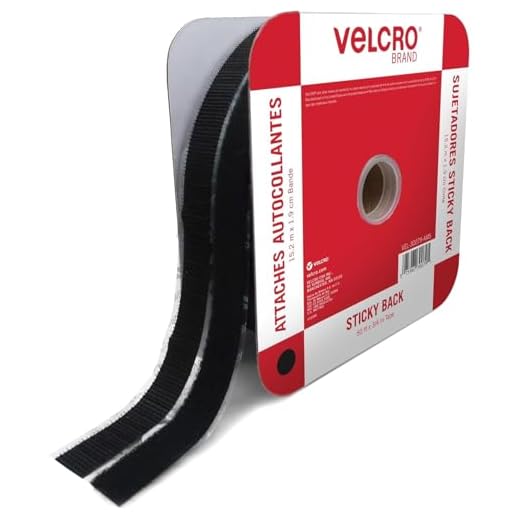

Choose high-quality adhesive strips designed for fabric to ensure a firm bond. Clean the area thoroughly before applying the new strips; any dust or residue can hinder adhesion.
Use scissors for precise cutting, ensuring the new fasteners match the original dimensions. Position them carefully to maintain functionality and aesthetics–alignment is key to seamless operation.
Allow adequate drying time as specified by the adhesive manufacturer. A sturdy bond is crucial for long-term use, especially in high-friction areas where wear is common.
Replacing Hook-and-Loop Fasteners on a Satchel
Use strong adhesive specifically designed for fabric applications to secure the new hook-and-loop strips effectively. Choose an adhesive that dries clear and is both washable and flexible.
Gather materials: new hook-and-loop strips, adhesive, scissors, and a ruler for precision.
- Cut the new strips to match the dimensions of the old fasteners. Aim for a tight fit to maintain closure strength.
- Carefully remove the worn sections using scissors or a seam ripper. Ensure the area is clean before applying the new pieces.
- Apply adhesive evenly to the backing of the new strips. Press firmly onto the designated area on the fabric.
- Allow the adhesive to cure as per the manufacturer’s instructions, usually 24 hours, to ensure a strong bond.
Reinforce corners with additional adhesive if the design allows, preventing peeling or separation over time.
Consider purchasing adhesive strips for easier replacement in the future, ensuring quick fixes without sewing tools.
Choosing the Right Type of Fastening for Your Carrier
Select a brand and variety that matches the weight and usage of your item. For daily use, opt for medium-duty types, while heavy-duty versions suit gear subjected to more stress.
Consider Material Compatibility
Ensure the chosen fastening integrates well with the fabric of your carrier. Nylon fasteners provide durability, while softer variants may be necessary for more delicate materials to prevent damage.
Adhesive Strength
Evaluate the bonding strength if the fastener uses adhesive. Heavy-duty adhesives work best for high-traffic areas, while lighter adhesives suffice for minimal use. For a secure hold, consider dual-sided options when applicable.
Tools Needed for Velcro Replacement
Prepare the following tools for a successful task: a pair of sharp scissors, a flathead screwdriver or seam ripper, and a strong adhesive for fabric. These will assist in removing old fasteners and applying the new components effectively.
To ensure a clean cut, opt for sharp scissors that can handle the thickness of the material. A flathead screwdriver or seam ripper will help lift and detach the previous attachments without damaging the surrounding fabric.
For securing the new strips, choose a high-quality adhesive formulated for fabric bonding. This will guarantee durability and long-lasting performance. Consider having a measuring tape handy to ensure precise alignment during the application.
If you’re considering upgrades, explore options that enhance both functionality and aesthetic appeal. Quality replacements can significantly improve usability and style, making your carrier more suitable for professional settings. For guidance on suitable travel options in professional settings, you might find insights in the best luggage for young professionals article.
Steps to Remove the Old Hook-and-Loop Fastener
Begin by gathering your tools: a pair of scissors and a flathead screwdriver. Cut the worn fastener as closely as possible to the fabric surface without damaging it.
If the adhesive remains, gently pry it off using the flathead screwdriver. Insert the blade between the adhesive and the fabric, carefully lifting it away. Take care not to tear the material underneath.
For stubborn remnants, apply heat from a hairdryer on a low setting. This softens the adhesive, making it easier to peel away. Keep the hairdryer at a distance to prevent fabric damage.
After removal, clean the area with rubbing alcohol to eliminate any leftover glue. This ensures a smooth surface for the new fastener. Allow it to dry completely before proceeding with attachment.
| Step | Action |
|---|---|
| 1 | Gather scissors and a flathead screwdriver. |
| 2 | Cut the old fastener close to the fabric. |
| 3 | Pry off any remaining adhesive using a screwdriver. |
| 4 | Apply heat to stubborn adhesive with a hairdryer. |
| 5 | Clean the surface with rubbing alcohol. |
Preparing the Surface for New Fasteners
Ensure that the workspace is clean and well-lit. Begin by thoroughly cleaning the area where the old fasteners were attached. Use rubbing alcohol or a mild soap solution with a soft cloth to remove any residue. This guarantees a strong bond for the new adhesive.
After cleaning, inspect the fabric for any signs of damage or fraying. If there are tears, repair them using fabric glue or a needle and thread, allowing it to dry completely before proceeding.
For optimal adhesion, gently roughen the surface with fine-grit sandpaper. This increases the bond’s effectiveness by providing a better grip for the new components.
Finally, ensure the surface is dry and free from dust. Dust particles can interfere with adhesion, leading to weak attachment.
Applying the New Fastener: Techniques and Tips
Align the new strip carefully to ensure proper adhesion. Use a ruler for precise placement, maintaining equal margins from edges. Press firmly along the entire length to secure the bond.
Heat Activation
If using heat-activated options, apply a low setting with an iron over a cloth for a smooth finish. Ensure the heat is evenly distributed to avoid damaging the fabric underneath.
Testing Adhesive Strength
After installation, let it sit for a few hours before testing. Gently lift the flap multiple times to check adherence. If the bond feels weak, consider additional pressing or reinforcing with a fabric glue compatible with your materials.
For further information on tools, you can explore are DSLR cameras automatic.
Testing the New Fasteners for Durability
Conduct a pull test on the newly installed fasteners to determine their strength. Secure one end to a stable surface and pull the opposite end with a consistent force. Measure how much weight the closure can hold before it separates.
Perform a repetitive opening and closing test. This simulates regular usage and helps identify any potential failures. Aim for at least 50 cycles to gauge longevity under stress.
Check resistance to dirt and moisture. Expose the new closures to light moisture or dirt and assess their functionality afterward. Clean them and see if they still adhere effectively; this reflects how they’ll perform in everyday settings.
Inspect for wear after prolonged use. After several days of regular handling, examine the surface condition for fraying or discoloration, signs that may indicate durability issues.
Review customer feedback on the specific type of fastener used. Research reviews for longevity and performance to make informed decisions based on experiences shared by others.
Record your findings for future reference. Documenting the performance metrics can help in assessing the reliability of the chosen fastener type over time and guide future repairs or replacements.
FAQ:
What materials do I need to replace the Velcro on my messenger bag?
To replace Velcro on your messenger bag, you will need a few materials: new Velcro strips (make sure to choose the appropriate size and type, either hook and loop), scissors, a seam ripper or utility knife, needle and thread (if you plan to sew it on), or fabric adhesive (for a no-sew option). A ruler or measuring tape can also be helpful to measure the right length before cutting.
How do I remove the old Velcro from the bag?
Removing old Velcro can be straightforward. Use a seam ripper or a utility knife to carefully cut the stitches holding the Velcro in place. If the Velcro is glued, you may need to carefully peel it off, applying some heat with a hairdryer can help loosen the adhesive. Take care not to damage the fabric of the bag while you are doing this. Once the old Velcro is gone, clean off any leftover adhesive residue with rubbing alcohol for a smooth surface.
Can I replace Velcro on my messenger bag without sewing?
Yes, you can replace Velcro without sewing by using fabric adhesive. After removing the old Velcro, clean the surface and apply the fabric adhesive according to the manufacturer’s instructions. Next, press the new Velcro strips firmly onto the surface. It’s important to let it cure for the recommended period, which may vary by product, to ensure a strong bond. Be sure to choose a fabric adhesive that is suitable for use on your bag’s material.
How can I ensure the new Velcro lasts a long time?
To ensure your new Velcro lasts, choose high-quality Velcro suitable for heavy use, as this can affect durability. When applying, make sure that the adhesive is properly cured if you are using glue. Avoid overloading the Velcro with items that are too heavy, as excessive weight can weaken the bond. Regularly check the Velcro for signs of wear and clean it periodically to remove dirt and lint, which can affect its locking ability. Proper care can significantly extend the life of your new Velcro strips.







